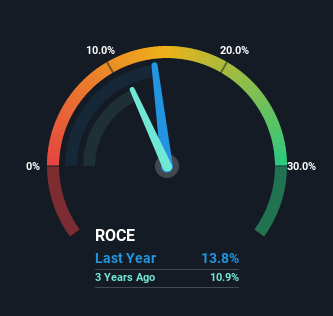If you're looking for a multi-bagger, there's a few things to keep an eye out for. Typically, we'll want to notice a trend of growing return on capital employed (ROCE) and alongside that, an expanding base of capital employed. Basically this means that a company has profitable initiatives that it can continue to reinvest in, which is a trait of a compounding machine. With that in mind, we've noticed some promising trends at Nava (NSE:NAVA) so let's look a bit deeper.
Return On Capital Employed (ROCE): What Is It?
Just to clarify if you're unsure, ROCE is a metric for evaluating how much pre-tax income (in percentage terms) a company earns on the capital invested in its business. To calculate this metric for Nava, this is the formula:
Return on Capital Employed = Earnings Before Interest and Tax (EBIT) ÷ (Total Assets - Current Liabilities)
0.14 = ₹13b ÷ (₹120b - ₹25b) (Based on the trailing twelve months to December 2022).
So, Nava has an ROCE of 14%. On its own, that's a standard return, however it's much better than the 10% generated by the Industrials industry.
See our latest analysis for Nava

Historical performance is a great place to start when researching a stock so above you can see the gauge for Nava's ROCE against it's prior returns. If you want to delve into the historical earnings, revenue and cash flow of Nava, check out these free graphs here.
What Does the ROCE Trend For Nava Tell Us?
Nava is displaying some positive trends. The numbers show that in the last five years, the returns generated on capital employed have grown considerably to 14%. The company is effectively making more money per dollar of capital used, and it's worth noting that the amount of capital has increased too, by 38%. So we're very much inspired by what we're seeing at Nava thanks to its ability to profitably reinvest capital.
The Bottom Line On Nava's ROCE
To sum it up, Nava has proven it can reinvest in the business and generate higher returns on that capital employed, which is terrific. And with the stock having performed exceptionally well over the last five years, these patterns are being accounted for by investors. So given the stock has proven it has promising trends, it's worth researching the company further to see if these trends are likely to persist.
Nava does have some risks, we noticed 2 warning signs (and 1 which is potentially serious) we think you should know about.
For those who like to invest in solid companies, check out this free list of companies with solid balance sheets and high returns on equity.
Valuation is complex, but we're here to simplify it.
Discover if Nava might be undervalued or overvalued with our detailed analysis, featuring fair value estimates, potential risks, dividends, insider trades, and its financial condition.
Access Free AnalysisHave feedback on this article? Concerned about the content? Get in touch with us directly. Alternatively, email editorial-team (at) simplywallst.com.
This article by Simply Wall St is general in nature. We provide commentary based on historical data and analyst forecasts only using an unbiased methodology and our articles are not intended to be financial advice. It does not constitute a recommendation to buy or sell any stock, and does not take account of your objectives, or your financial situation. We aim to bring you long-term focused analysis driven by fundamental data. Note that our analysis may not factor in the latest price-sensitive company announcements or qualitative material. Simply Wall St has no position in any stocks mentioned.
About NSEI:NAVA
Nava
Engages in ferroalloy manufacturing, energy, mining, agribusiness, and operation and maintenance services in India, Zambia, the United States, Hong Kong, Japan, the United Arab Emirates, and internationally.
Flawless balance sheet established dividend payer.
Market Insights
Community Narratives



